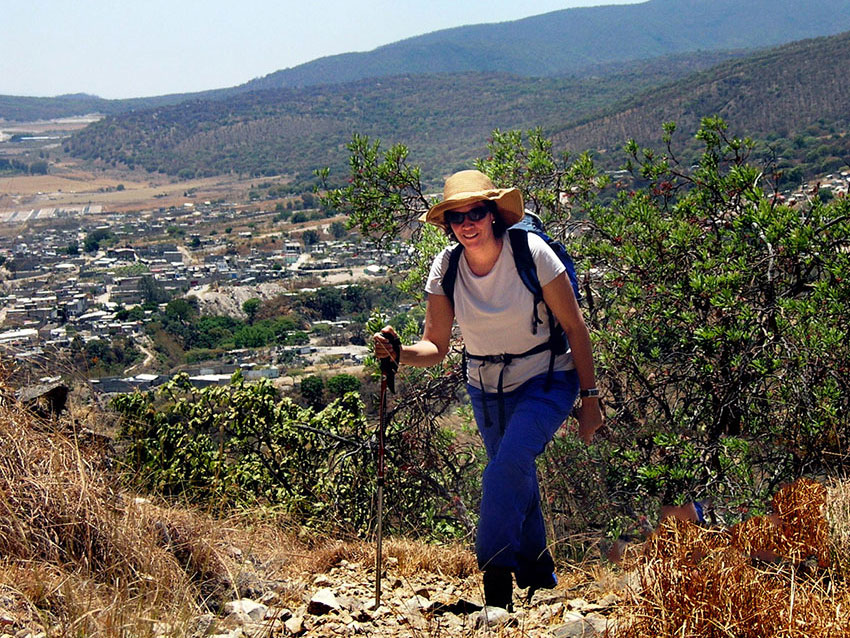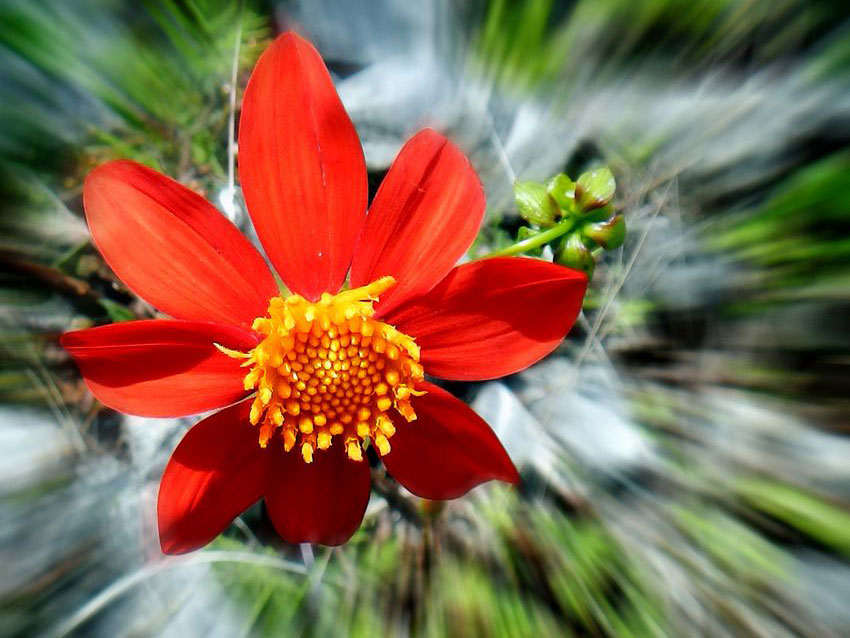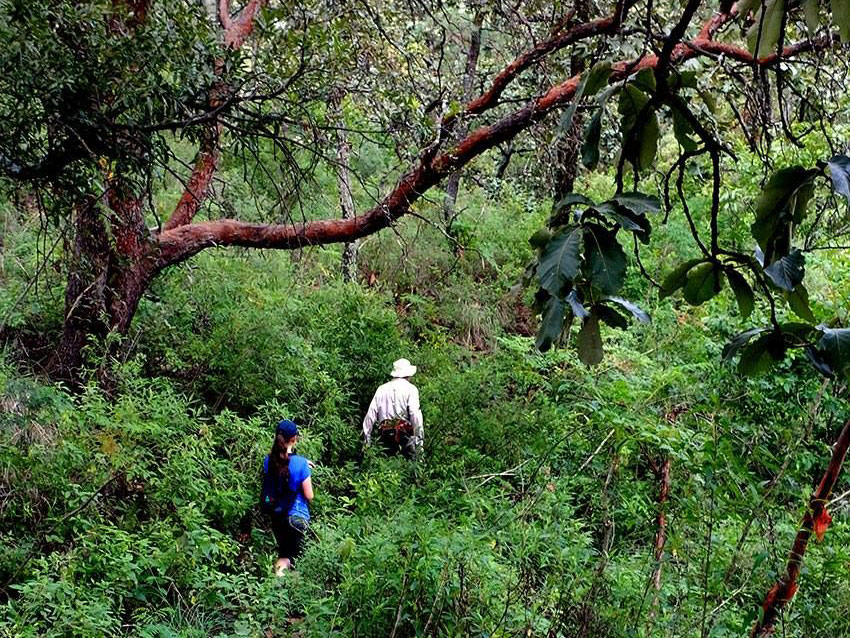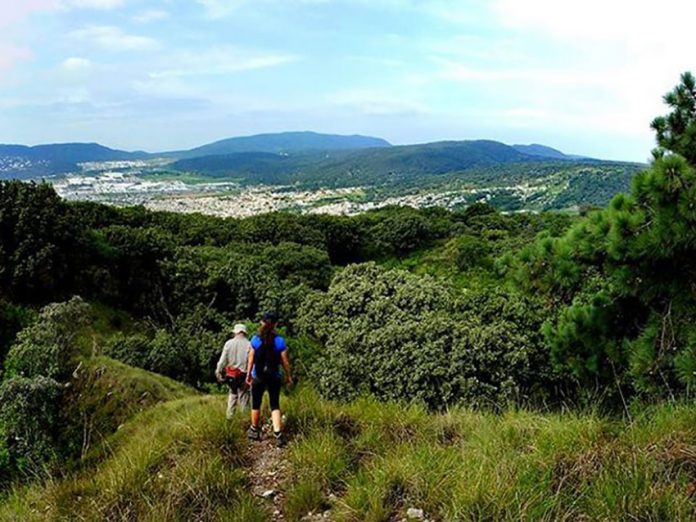A number of years ago I was chatting with the guard at Guadalajara’s thousand-year-old Ixtepete Pyramid, located at the west end of the city. As is my custom, I naturally asked him if he knew of any caves in the area.
“Right up there,” he replied, pointing toward a high ridge above us, “That’s El Cerro del Colli and people say there’s a deep cave with smooth walls somewhere on top.”
Of course, the following weekend found my caving friends and me at the foot of Colli, trying to figure out how we were going to get to the top of the nearly vertical 200-meter-high wall facing us.
Eventually we found a very steep trail and we reached the top, where we discovered a beautiful forest and several lookout points offering spectacular views of Guadalajara. Fortunately, we did not find the cave, which a University of Guadalajara professor later told us was, in reality, a vent through which hot gases occasionally escape.
“You could easily have been cooked alive had you gone inside it,” he warned.

El Cerro del Colli, we learned, marks the exact spot where the last volcanic eruption occurred in this area, 25,000 years ago.
I didn’t attempt climbing Colli again for several years. Then one day I happened to be driving near the southern end of this great volcanic plug (which has a diameter of about 1.8 kilometers). From the street I could see a big white cross up near the top and I figured there must surely be a path leading to it. Well, I asked a lot of local people about this and they said, yes, there’s a vereda, but not one of them had ever walked up it.
Eventually I discovered a steep, zigzagging trail that takes you to the cross in 20 minutes. From that point you have a magnificent view of the ever-expanding city … and cool breezes to boot.
Amazingly, if you keep following that path upward another 10 minutes you’ll feel like you’ve been wafted a hundred miles away from civilization. It’s dead quiet on top of old Colli, except for the songs of birds and the whistling of the cool breeze through the pine and oak trees.
Here you can wander all day and never run into a human being, but what you will run into are picturesque rolling hills, and flowers — lots of flowers, particularly in the months of August and September.
So fascinating were those flowers that I managed to talk two botanists from the University of Guadalajara to visit Colli and help me ID some of its flora. I brought along a few hiker friends as well, which turned out to be a less than brilliant idea, as I soon found out. You see, when you are on a path in the woods with a botanist, the word “hiking” does not describe the experience. “Creeping along the trail” would be more exact.

Right off, we came upon begonias and morning glories and the first of many scarlet-flowered dahlias (Dahlia coccinia) which, of course, is the Mexican national flower, named for the Swedish botanist Anders Dahl, who thought its edible bulb would make a good alternative to potatoes. According to Green Deane, author of Eat the Weeds, “Dahlias as food had some success in France and the Mediterranean area, but their slightly bitter flavor (then) kept them from going mainstream.”
Next we saw a Cuphea llavea which, in English, is known as a bat-faced cuphea. I have to admit it may be an appropriate name for this weird-looking flower, but bats might object (if they were able to defend themselves), pointing out that beauty resides in the eye of the beholder and that humans would never even qualify for a bat beauty contest.
Taking one more step, we spotted the climbing vine of magic beans (Canavalia villosa) which, I learned later, are both aphrodisiacal and psychedelic.
Another curious flower we found all along the trail is the fiery red Pitcarnia which I was amazed to discover is in the bromelia family but grows on the ground rather than in trees. Yet another plant that appeared here and all along the trail is Commelina dianthifolia, the bird-bill dayflower — intensely blue in color and considered “a very rare plant indeed” by gardening experts Thompson and Morgan. It is called the dayflower because it opens in the morning but withers before the day is done. For this reason, it is also known (sarcastically) as widows tears.
Well, those are just a few of the wildflowers we saw hiking up the east face of Colli, not to mention trees like the guaje, tepame, clethra, papelillo and the spike-covered ceiba or silk-cotton tree.
Once you get on top of the hill, at an altitude of around 1,900 meters above sea level (6,233 feet) you leave the temperate zone and plunge right into a different ecosystem: a dense forest of pines and oaks. You can’t help notice the difference: it’s now cool and shady. Here you can also find smooth-barked madroño trees and an occasional agave bruto, which is used not to make tequila, but rope.

In your wanderings you will occasionally pop out of the forest and find yourself standing on a ledge gasping at the magnificent view of Guadalajara, spread before you as far as the eye can see.
The top of Colli is crisscrossed with beautiful, pleasant caminos, in great contrast to the steep, dusty, rock-strewn trails that get you up there. But, if you persevere, you will be rewarded and you’ll get plenty of good exercise in the bargain. Remember to go there in August or September when the “colliflowers” are in full bloom!
As for the possibility of experiencing a geothermal explosion while you’re on top of old Colli, geologists say this volcano erupts every 25,000 years and, as I mentioned before, the last eruption was 25,000 years ago … so don’t forget your camera: you may end up taking the hottest YouTube video ever!
To reach the trail head leading up to the cross, ask Google Maps to take you to “Calle Galeana 55, Balcones del Sol, Zapopan, Jalisco.” Walk northwest to the end of the street and start hiking up the mountain. Once you are on top, there are kilometers of trails. Just follow your nose!
A while ago I led a hike, sponsored by Bakpak magazine, along some of Colli’s trails. While sitting atop one of the miradores, I asked participants for their comments and here are a few:
“To tell the truth I was quite surprised to discover that right here on the edge of the city we have trails that put us into contact with nature.” –Lupita
[soliloquy id="114545"]
“I like the fact that you are almost instantly inside the forest, immersed in wonderful smells, like right here, with anise all around us, and suddenly there’s a hawk flying above us, welcoming us to this marvelous place.” –Emanuel
“… The variety of flowers and the silence … the sound of the wind blowing through the trees.” –Rómulo
The writer has lived near Guadalajara, Jalisco, for more than 30 years and is the author of A Guide to West Mexico’s Guachimontones and Surrounding Area and co-author of Outdoors in Western Mexico. More of his writing can be found on his website.
